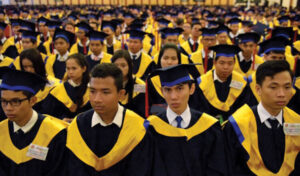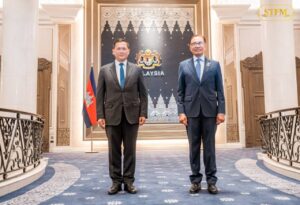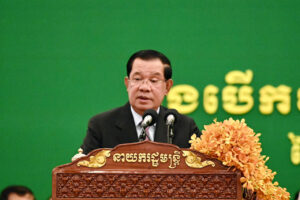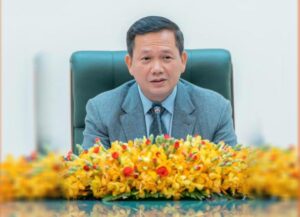(Video) Selected Comments Samdech Moha Bovor Thipadei Hun Manet, at the construction site of the twin flyovers along the Samdech Techo Hun Sen Blvd. intersecting with National Road 2 at the border of Phnom Penh and Kandal [Unofficial and translations]
[1]
(1) Phnom Penh grows in size, population and the means of transportation – in quantitively and qualitatively
[…] Over the decades, Phnom Penh has developed both quantitatively and qualitatively. In quantity, we refer to numbers. (Firstly,) the area of Phnom Penh has increased from 300 square kilometers to nearly 700 square kilometers […] secondly, the people living and working in Phnom Penh have now reached about three million people […] and thirdly, currently, there are about two million motorbikes and cars […] it is not possible to stop the people of Phnom Penh from having more children, from buying cars/motorbikes […] I still encourage people to have better means of transportation whereas the state continues to build more infrastructure to solve congestion problem […]; and, speaking of quality, we refer to the state of richness and better standard of living. The standard of living of our people everywhere, especially in Phnom Penh, has been steadily improving […] farmland have been transformed to be residential and factories land, where jobs are created. This 60-meter road is a testament to the reality […] once the economy in one place grows, it influences and pulls the economy of the surrounding area to grow too […]
(2) Should Phnom Penh be at the same as in 1980s, there would be no need to expand infrastructures
We have demand for prosperity and infrastructure as the economy grows. When people traveled by bicycle, there was no need to build a highway. When a small number of people have transportation, there needs not plan to widen the road. If Phnom Penh (is at the same level) from 1980, we do not need to widen the road as there would not be this many cars or motorcycles […] in line with the population growth, it required us to create achievements in both quantity and variety. We have transformed dirt roads to paved roads, to concrete roads from the width of five meters to 10 meters, 20 meters, 30 meters, 40 meters, 50 meters, and even 60 meters. From normal roads to flyovers, and in ceetain locations, we evenn built short tunnels […] the main problem of propserity in Phnom Penh is parking space […] now there is a proposal to design a building for parking and to be managed with technology […] why? It is because of the population growth but also the increase in the number of people who can afford to buy their means of transportation […]
(3) The state of having plenty confirms the growth of Phnom Penh and the provinces throughout the country
(Our country/city has) had modern structures, plenty of roads, buildings that are catering to the needs of the people […] this richness confirms the quality of development of not only Phnom Penh but also in all provinces […] so there must be good order […] people no longer die on the battlefield. People live longer because they have better health […] and their (life expectancy) are longer. Our average life expectancy before was 50 years, and now it has reached the age of 60 years, 70 years, 78 or 79 years […] the government has come up with two solutions. One is a reactive mode. It means to meet the immediate needs […] there has been a consideration about limiting the year of production for imported cars. I said that is not applicable. We in fact should strengthen the car mechanical checking system, […] it is not necessary to limit by the year of production yet […]
(4) Social protection policy and promotion of education from kindergarten to higher education, including vocational training for health and competence
Then we are dealing with health and ability. What do people want? They wanted to live in good health, starting from adequate nutrition […] in the health system, we want remote villages and communes to have health posts, health centers, and referral hospitals that have sufficient capacity […] and strengthen the health system through the introduction of other social protection policies, provision of poor ID cards to help the people. About the capability/ability (we are providing people with a chance) to learn. We promote education from kindergarten to higher education, including vocational training. To have a chance to learn and to be capable, and to have good health, to be able to make a living independently, living on your own rather than be provided by someone – which means we want to obtain chance for jobs. We set out a policy to create local jobs and those self-employed people can do their own business […]
(5) To study the construction of light rail, future subway transportation system and increase the public transport service lines
With more roads are put into use, there are more infrastructures to connect people (and they are easy to travel). In this area now, and the same as other areas, there are flyovers, short tunnels, and study is being conducted for light (rail transit) trains that can connect from the airport to the center of Phnom Penh (somewhere in order) to facilitate (traveling between). In the future, some places in Phnom Penh, both old and new (or satellite cities) can think of the underground transportation system […] we have to think of mass transit – public transport system – inevitably […] for a long future, there will be rail on and under the ground. That is something to ponder for the future. What we can do now and in the medium term ahead is to improve the bus system […] with this in mind, I would like to encourage the private sector to invest more in parking lots, especially modern-tech parking lots […]
(6) Organize proactive development in addition to reactive solutions
Taking into consideration of the master plan system, especially in the new urban satellite areas, must be carried out strictly […] we need to think in a proactive way. Previously, we talked about thinking in a reactive mode […] but the new places to be developed need to have actual consideration in this area […] the policy of the 7th legislative term government and the plan of the Ministry of Land Management together with the Ministry of Water Resources, Rural Development, and Interior, has been stressed on preparing better infrastuctures for the rural city or the villages/ communes, […]
We need to work out how much right of way is necessary so that it is not becoming an obstacle to prepare the water and electricity system later. We also have to take into consifderation issues concerning safety and security. We are not just thinking about private development. It includes also the people’s residetial villages […] the same applies in transports system. We think of walk way […] Kandal and Phnom Penh have great and fast development potential. Due to the Covid-19 story, the global economy, and the war in other places, despites theirimpacts of our economy, we could still accomplish 5% growth in 2023, 6% in 2024, and next year, the growth trend may still be positive. The economy in all sectors may recover […]
(7) Policy formulation not only for reaction/response but being proactive
Thousands and tens of thousands have been working in this area. The construction of the airport has yet to be completed, but it will open in 2025. Thousands are working in the airport project. This has not yet taken into consideration the potential expansion of this area. Soon there will be tens of thousands of houses built and ready […] we have been formulating policies that not only responds/reacts (to what we have encountered) but also to be proactive or think ahead. Even what we are doing for does not exist now, but we have to think that in 15 or 20 years ahead. Do not wait for the demand to come to dig and rearrange the roads […] and when the road is built and ready but there will then be no one using it, it will not prove cost effective. We therefore have to consider improving the public transport system, especially the city road […] where setting up the bus route is inportant […] the public transport mean to be used by many must be a priority […]
(8) Well-organized city taking into consideration not only the good buildings but also its surrounding
Thinking in a proactive way is necessary […] I have asked (the Minister of Energy and Mines) His Excellency Keo Rattanak to review the rules governing the gas system piping into people’s homes. In the time to come, there will be high-rise buildings and use gas system […] and there will be local suppliers […] proactive actions must be taken regarding construction, building, and city. I am asking the relevant ministries to really consider this. People need to live in peace, stability, security, safety, including the safety of living, like the installation of this building […] in addition to the physical infrastructure, let us think about residential wellbeing. Green areas must be developed. We can not live for 20 or 30 years in the surrounding of concrete buildings. There must be trees […] Some 100 or 200 hectares of land near to the provincial town should be kept to build a park in the future […] to organize a city that dwellers can live well and in comfortability, not only the good buildings that are taken into play but also the surrounding […]
(9) Now the twin flyovers may be a big achievement but in 20 years it will be a small achievement and/or one of many achievements
This has yet to mention the interests that are to come from the future Funan Techo canal that will create more economic activity in Takeo and Kandal provinces. Thus, the expansion to the southern part of Phnom Penh, those living in Dangkor district mainly, in Takeo, and Kandal, have great potential for the development for their children in the future […] in 20 or 30 some years, Tonle Bati and Phnom Tamao (of Takeo) will become the Phnom Penh suburbs. Although not in the administrative sense, it will be a highly developed area, where infrastructure and people’s livelihood will not be inferior to those in the city […]
There are so many possibilities that we would not be able to imagine what are to happen in 30 years […] In particular, the infrastructure and major achievements that are planned to happen are the international airport (that construction is in full swing) here and the Funan Techo canal, for which we will lay the foundation on the 5th of August. By then, it will not wait till our children generation, we will see for ourselves these achievements […] the flyovers that we are building here will be a big achievement now but in 20 years, it will be a small achievement and/or just one of many achievements […]
(10) From have-not to have, from having little to having many, and from asking others to help to do by ourselves Some people despise Cambodia very much that they blame us for bragging about these achievements – and compare us to a frog living in a pot […] we look around in our pot. Outsiders did not see what was in the pot and they could not value it. Only those in the pot see what were in there now, while there was nothing before […] we will continue to do so as we have now come to a stage that bringing us from have-not to have, from having little to having many, and from asking around for help to do things to being able to do by ourselves. The flyovers are built by OCIC using mainly the Cambodian engineers/workers. From the beginning, we relied on engineers from other countries. We have built two big lines of flyovers by entirely the Cambodian expertise […] we give access to the people. I am sure everything that the people want are independence based on learning opportunities, employment opportunities, raising children, opportunities to earn a living, self-management, housing, private property, all the things that they have full legal right to do […]./






